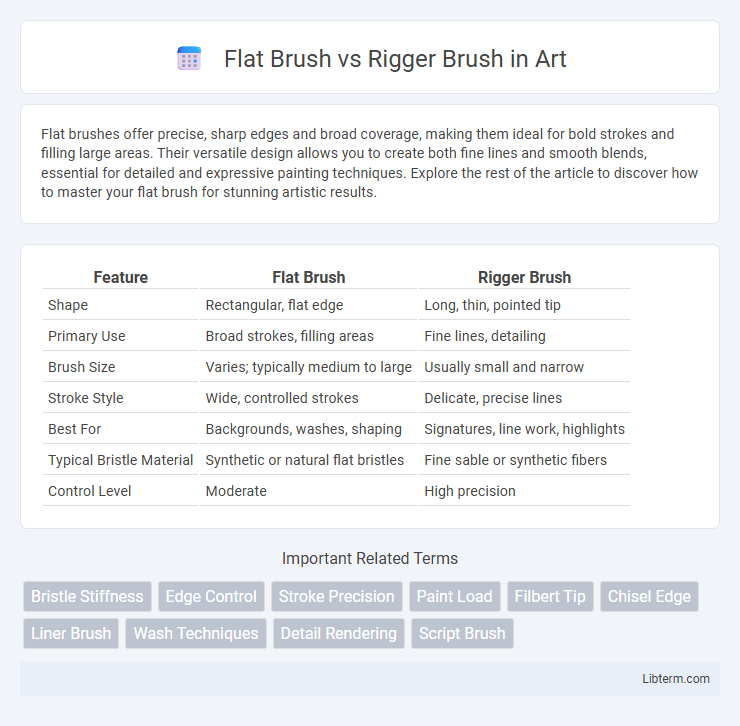Flat brushes offer precise, sharp edges and broad coverage, making them ideal for bold strokes and filling large areas. Their versatile design allows you to create both fine lines and smooth blends, essential for detailed and expressive painting techniques. Explore the rest of the article to discover how to master your flat brush for stunning artistic results.
Table of Comparison
| Feature | Flat Brush | Rigger Brush |
|---|---|---|
| Shape | Rectangular, flat edge | Long, thin, pointed tip |
| Primary Use | Broad strokes, filling areas | Fine lines, detailing |
| Brush Size | Varies; typically medium to large | Usually small and narrow |
| Stroke Style | Wide, controlled strokes | Delicate, precise lines |
| Best For | Backgrounds, washes, shaping | Signatures, line work, highlights |
| Typical Bristle Material | Synthetic or natural flat bristles | Fine sable or synthetic fibers |
| Control Level | Moderate | High precision |
Introduction to Flat and Rigger Brushes
Flat brushes feature a broad, rectangular shape ideal for bold strokes and filling large areas with smooth, even coverage, making them essential in acrylic and oil painting for creating sharp edges and blending. Rigger brushes, characterized by their long, thin bristles, allow artists to paint fine lines and intricate details, often used for precise work such as lettering, branches, and delicate highlights. Both brush types serve distinct roles in painting techniques, with flat brushes excelling in structure and coverage, while rigger brushes provide control for detail and finesse.
Defining Flat Brushes: Key Features
Flat brushes feature a rectangular shape with long, straight bristles that are ideal for creating sharp edges and broad strokes in painting. Their firm, wide bristle arrangement allows precise control and smooth coverage, especially suited for varnishes, block color, and bold, linear works. Compared to rigger brushes, flat brushes excel in techniques requiring strong, uniform lines and larger surface area coverage.
Understanding Rigger Brushes: Unique Characteristics
Rigger brushes feature long, thin bristles designed for precise, continuous lines, making them ideal for fine details like script lettering and intricate foliage in painting. Unlike flat brushes, which have broad, straight-edged bristles suited for coverage and bold strokes, rigger brushes excel in creating smooth, tapered lines with excellent ink or paint flow. Their unique shape and flexibility provide artists with control and versatility when executing delicate lines and delicate textures.
Best Uses for Flat Brushes in Painting
Flat brushes excel in creating bold, sweeping strokes and filling wide areas with consistent color, making them ideal for painting backgrounds and broad shapes. Their stiff bristles and square edges allow for both precise straight lines and soft edges, perfect for techniques like blocking in and blending. Artists often use flat brushes for oil, acrylic, and watercolor mediums to achieve vibrant, textured effects and smooth transitions.
When to Choose a Rigger Brush
Choose a rigger brush when fine, precise lines or intricate details are required, such as painting delicate branches, hair strands, or script text. Its long, thin bristles hold paint well and provide exceptional control for creating continuous, smooth strokes. In contrast, flat brushes excel at filling broad areas and making bold, straight edges, making them less ideal for detailed work.
Comparing Stroke Techniques: Flat vs Rigger
Flat brushes create bold, broad strokes with sharp edges, ideal for filling large areas and making defined lines in painting. Rigger brushes produce fine, consistent lines suitable for intricate details, such as delicate foliage or script-like strokes. Comparing these stroke techniques highlights how flat brushes excel in filling and shaping, while riggers enable precision and fluidity in line work.
Paint Types and Compatibility
Flat brushes excel with acrylics and oils, providing broad strokes and smooth coverage due to their stiff bristles and flat shape. Rigger brushes, characterized by long, thin bristles, work best with watercolors and inks for fine lines and detailed work. Compatibility hinges on brush stiffness and paint viscosity, making flat brushes ideal for thick, opaque paints and rigger brushes perfect for fluid, transparent mediums.
Pros and Cons: Flat vs Rigger Brushes
Flat brushes offer broad, even strokes ideal for covering large areas and creating sharp edges, but they lack the precision needed for intricate details. Rigger brushes excel in fine lines and detailed work due to their long, thin bristles but can be challenging for broader coverage and require steady hand control. Choosing between flat and rigger brushes depends on the painting technique, desired effect, and level of detail needed.
Tips for Beginners: Selecting the Right Brush
Beginners should choose a flat brush for broad strokes and filling large areas, as its stiff bristles provide control and precision. A rigger brush, with its thin, pointed tip, is ideal for fine lines, detailing, and delicate work such as painting grasses or hair. Understanding the purpose of each brush helps new artists achieve desired textures and enhance their painting techniques effectively.
Conclusion: Which Brush Suits Your Artistic Needs?
Choosing between a flat brush and a rigger brush depends on your painting style and desired effects. Flat brushes provide broad, even strokes ideal for filling large areas and creating sharp edges, while rigger brushes excel at fine lines and intricate details with their long, thin bristles. Evaluating your project's requirements will help determine which brush aligns best with your artistic techniques and enhances your overall artwork.
Flat Brush Infographic

 libterm.com
libterm.com